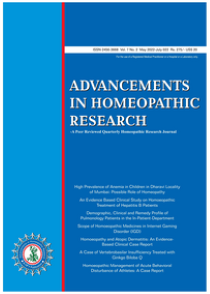Addressing Obesity Through Homeopathy
DOI:
https://doi.org/10.48165/ahr.2025.10.3.6Keywords:
Obesity, obedere, over eat, obesitas, being very fatAbstract
The word ‘Obesity’ came from Latin word; where the verb ‘obedere’ means ‘over eat’ and ‘obesitas’ means ‘being very fat’. Obesity is a health condition in which the natural energy stored, reserved in the fatty tissue of human beings, is increased to that point where it is linked with certain health issues. It can be defined in relative or absolute terms. Practically, it is evaluated in absolute terms by measuring BMI (body mass index), but also in terms of its distribution through waist circumference or waist-hip circumference ratio measurements. The normal amount of body fat (expressed as percentage of body fat) is between 26-30% in female and 19-24% in male. Female with over 30% body fat and male with over 25% body fat are considered as obese. Women of reproductive age have higher rates of overweight and obesity and are more adversely affected by obesity-related complications than men. This gender difference is mainly due to general weight gain during childbearing years, gestational weight gain and weight retention, adverse lifestyle, or risk factors associated with pregnancy and the postpartum period. Maternal obesity increases the risk of numerous complications including pregnancy, labour and birth for both the mother and the child, diabetes and hypertensive disorders etc. Compared with normal weight, maternal overweight is associated with a higher risk of caesarean delivery and a higher incidence of anaesthetic and postoperative complications. Low Apgar scores, macrosomia and neural tube defects are also more frequent in infants of obese mothers compared with infants of normal weight mothers. Obesity may be caused by a number of social, cultural, behavioral, physiological, metabolic, and genetic factors that are beyond the person's control. Obesity is most commonly caused by a combination of excessive food energy intake, lack of physical activity, and genetic susceptibility, although a few cases are caused primarily by genes, endocrine disorders, medications or psychiatric illness. It is associated with increased risk of medical illness, disability, and death. It is a metabolic disorder that is primarily induced and sustained by an over consumption and underutilization of caloric substrate.
References
Ahirwar, R., & Mondal, R. P. (2019). Prevalence of obesity in India: A systematic review. Diabetes & Metabolic Syndrome: Clinical Research & Reviews, 13(1), 318–321. https://doi.org/10.1016/j.dsx.2018.08.032
Das, P. C., & Das, P. K. (2005). Textbook of Medicine (5th ed., pp. 509–510). Kolkata: Current Book International.
Labib, M. (n.d.). The investigation & management of obesity. National Center for Biotechnology Information. Available from http://www.ncbi.nlm.nih.gov
Davidson, R. W. E., Edwards, A. D., & Bowchier, C. (2014). Davidson’s Principles & Practice of Medicine (22nd ed., pp. 301–302). Edinburgh: Elsevier.
Fauci, A. S., Braunwald, E., Kasper, D. L., Hauser, S. L., Longo, D. L., Jameson, J. L., et al. (2008). Harrison’s Principles of Internal Medicine (17th ed.). New York: McGraw Hill.
Munjal, Y. P. (2012). API Textbook of Medicine (9th ed.). Mumbai: The Association of Physicians of India.
Sandhu, R., & Chandora, C. (2018). Cure of obesity in homeopathy: An approach to control a global epidemic. TUJ Homeopathy & Medical Science, 1(1), 17–22.
Monami, M., Silverii, A., & Mannucci, E. (2019). Alternative treatment or alternative to treatment? A systematic review of randomized trials on homoeopathic preparations for diabetes and obesity. Acta Diabetologica, 56(2), 241–243. https://doi.org/10.1007/s00592-1235-7
Vilhena, E. C., & Castilho, E. A. (2016). Homoeopathic treatment of overweight and obesity in pregnant women with mental disorders: A double-blind, controlled clinical trial. Alternative Therapies in Health & Medicine, 22(S3), 14–22.
Singh, A. K., Mahajan, N., & Tripathi, V. (2016). Efficacy of constitutional homoeopathic medicine in obesity. Advances in Homeopathic Research, 1(1), 28–38.
Misael, P. S. E., De Guadalupe, T. M. B. M., Paola, D. C. S. G. M., & Carlos, R. L. J. (2014). Effect of Cynara scolymus (artichoke) in homoeopathic doses on body mass index in obese and overweight patients. Biomedical & Pharmacology Journal, 7(2), 525–533.
Paola, D. C. S. G. M., Miseal, P. C. E., & Carlos, R. L. J. (2014). The effect of nutrition and homoeopathic treatments versus exclusive nutritional treatments in patients with obesity or overweight. Biomedical & Pharmacology Journal, 7(2), 481–490.
Denisova, T. G., Gerasimova, L. I., Pakhmutova, N. L., Mahesh, S., & Vithoulkas, G. (2018). Individualized homoeopathic therapy in a case of obesity, dysfunctional uterine bleeding, and autonomic dystonia. American Journal of Case Reports, 19, 1474–1479. https://doi.org/10.12659/AJCR.913328
Bueno, P. C. S., Barbalho, S. M., Guiguer, E., Ceolin, L. S. N., Panobianco, M. G., Souza, N. V., et al. (2017). The potential role of hypothalamus (homeopathy) in the treatment of obesity. International Journal of Development Research, 7(9), 15226–15229.
Kiran, G. R., & Raju, A. B. (2014). Anti-obesity effect of Phytolacca berry in rats. Environmental and Experimental Biology, 12, 95–99.
Fauci, A. S., Braunwald, E., Kasper, D. L., Hauser, S. L., Longo, D. L., Jameson, J. L., & Loscalzo, J. (2012). Harrison’s Principles of Internal Medicine (18th ed., Vol. 1). New York: McGraw Hill.
Boericke, W. (2007). Pocket Manual of Homoeopathic Materia Medica and Repertory: Comprising the Characteristic and Guiding Symptoms of All Remedies (Clinical and Pathogenetic), Including Indian Drugs. New Delhi: B. Jain Publishers Pvt. Ltd.
Allen, H. C. (2004). Allen’s Keynotes, Rearranged and Classified with Leading Remedies of the Materia Medica & Bowel Nosodes (9th ed., Reprint). New Delhi: B. Jain Publishers Pvt. Ltd.




